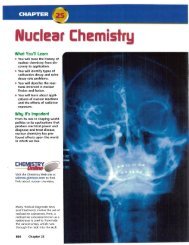Solutions
Solutions
Solutions
Create successful ePaper yourself
Turn your PDF publications into a flip-book with our unique Google optimized e-Paper software.
CHAPTER '<br />
STUDY GUIDE<br />
Summary<br />
15.1 What are solutions'<br />
• A solute dissolves in a solvent during a process<br />
called solvation. When the solvent is water, the<br />
process also is called hydration.<br />
• Every substance has a characteristic solubility in a<br />
given solvent.<br />
• Factors that affect solubility include the nature of<br />
the solute and solvent, temperature, and pressure.<br />
• Henry's law states that the solubility (5) of a gas in<br />
a liquid is directly proportional to the pressure (P)<br />
of the gas above the liquid at a given temperature.<br />
15.2 Solution Concentration<br />
• The concentration of a solution is a quantitative<br />
measure of the amount of solute in a given amount<br />
of solvent or solution.<br />
• Measures of concentration include mass and volume<br />
percentages, molarity, molality, and mole fraction.<br />
• A dilute solution can be prepared from a more concentrated<br />
standard stock solution.<br />
15.3 Colligative Properties of <strong>Solutions</strong><br />
• Physical properties affected by the concentration of<br />
the solute but not the nature of the solute are called<br />
colligative properties.<br />
• Colligative properties of solutions include vapor<br />
pressure lowering, boiling point elevation, freezing<br />
point depression, and osmotic pressure.<br />
15.4 Heterogeneous Mixtures<br />
• One of the key differences between solutions, colloids,<br />
and suspensions is particle size.<br />
• The random motion of colloidal dispersions due to<br />
molecular collisions is called Brownian motion.<br />
• The scattering of light by colloidal particles is called<br />
the Tyndall effect. The Tyndall effect can be used to<br />
distinguish colloids from solutions.<br />
Key Equations and Relationships<br />
S1<br />
S2<br />
• Henry's law: - = -<br />
(p. 460) P1 P 2<br />
• Percent by mass = mass of solu~e x 100<br />
(p. 463)<br />
mass of solution<br />
• Percent by volume = volume of solu~e x 100<br />
(p. 464)<br />
volume of solutIon<br />
moles of solute<br />
• Molarity (M) = liters of solution<br />
(p.464)<br />
• Molarity-volume relationship: M 1 V 1 = M 2 V 2<br />
(p.467)<br />
• Molality (m) =<br />
(p. 469)<br />
. moles of solute<br />
kilogram of solvent<br />
• Mole fractions: X A<br />
= n A X B<br />
= n B<br />
(p. 470) nA + nB nA+ nB<br />
• Boiling point elevation: I1T b = Kbm (p. 472)<br />
• Freezing point depression: I1Tf = Kfm (p. 473)<br />
Vocabulary<br />
• boiling point elevation (p. 472)<br />
• Brownian motion (p. 478)<br />
• colligative property (p. 471)<br />
• colloid (p. 477)<br />
• concentration (p. 462)<br />
• freezing point depression<br />
(p.473)<br />
• heat of solution (p. 457)<br />
• Henry's law (p. 460)<br />
• immiscible (p. 454)<br />
• insoluble (p. 454)<br />
• miscible (p. 454)<br />
• molality (p. 469)<br />
• molarity (p. 464)<br />
• mole fraction (p. 470)<br />
• osmosis (p. 475)<br />
• osmotic pressure (p. 475)<br />
• saturated solution (p. 458)<br />
• solubility (p. 457)<br />
• soluble (p. 454)<br />
• solvation (p. 455)<br />
• supersaturated solution (p. 459)<br />
• suspension (p. 476)<br />
• Tyndall effect (p. 479)<br />
• unsaturated solution (p. 458)<br />
• vapor pressure lowering (p. 472)<br />
Study Guide 483












